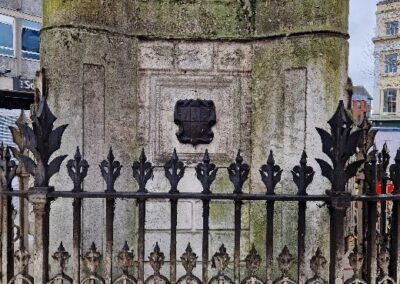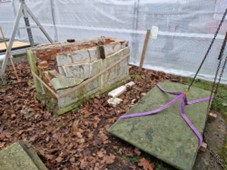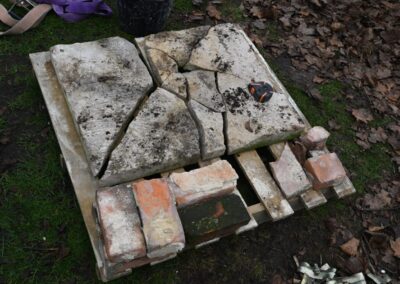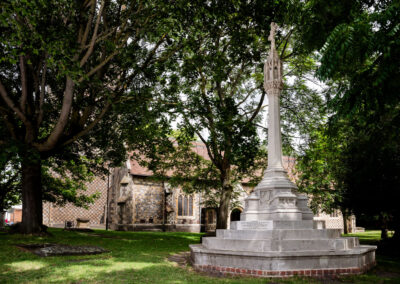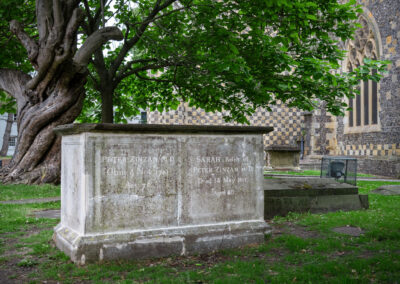STONEWORK REPAIRS AND THERMATECH CLEANING
Project overview
Reading Borough Council appointed Cliveden Conservation to carry out a series of High Street Heritage Action Zone (HSHAZ) funded monument cleaning and conservation projects. The four historic monuments included the Harrison Cross. The Queen Victoria Statue, the Simeon Monument and the Zinzan Tomb, St Mary’s churchyard.
Summary of the conservation work carried out
Cleaning the monuments was carried out according to the architect’s instructions and varied according to the condition of the material. Conservators were able to prevent over-cleaning or causing damage to fragile areas by appropriately adjusting the application of a ThermaTech high pressure steam system. Any vegetation was removed from the monuments and fungicidal wash was used where suitable.
The Harrinson Cross. (known as the ‘Jubilee Cross’)
Conservators replaced missing or damaged bricks and raked out the exposed brickwork joints before repointing with lime mortar. The displaced step was shifted back into the correct position using heavy duty rubber mallets and wooden wedges. Finally, the diminished lead lettering was recorded and the surface cut back for re-lettering.
Simeon Monument
Conservators revealed a loose historic indent repair to the axe-head on the north corner, this was consolidated using lime mortar. The three bronze plaques were re-patinated and hot waxed by a specialist metalwork subcontractor. Conservators treated the metal railings for rust before repainting them.
The Queen Victoria Statue
The large visible crack on three sides of the plinth held together with dog cramps was filled using a fine lime mortar. The square granite plinth base was also repointed and the spiked chains around the monument reinstated.
Zinzan Tomb
Conservators were challenged by removing the tomb lid and recovering all the fragments of the broken side panels. Cliveden Conservation’s stonemason pieced the side panels together by cutting slots across the breaks and inserting lengths of 6mm basalt bar set in polyester resin.
The side panels and slips to the tomb plinth were then reattached using lengths of 8mm basalt bar, and the rebuilt brick core using stainless steel dog cramps set in polyester resin. Open joints and fine cracks were pointed and filled using lime mortar. The tomb lid was cleaned before being replaced on a bed of lime mortar and the joint pointed up. Lastly, the inscriptions on three sides were sharpened.
Result
The appearance of the four monuments has been greatly improved through sensitive cleaning. Working in close collaboration with the architect, Cliveden Conservation has successfully carried out all the necessary repairs, slowed down weather damage and prevented further deterioration. The Zinzan Tomb’s future has been saved and is an excellent example of skilled stonemasonry.
Photo credit: Simon Camper | Lumen Photography Ltd.
Project details
Client:
Reading Borough Council
Cliveden Conservation
Category:
Advisory and material analysis | Stonework
What we did
“The work done by Cliveden Conservation’s stone mason to rescue the chest tomb, including the partial re-building of the brick core walls, the cleaning and pinning of the facing slabs and the insertion of a number of stone indents was exemplary and left the monument looking its old self rather than something new. The ‘sharpening’ of the inscriptions covering five members of the Zinzan family has had the spectacular effect of reclaiming a piece of Reading’s local history for the public domain.
With regards to the Harrinson Cross, Cliveden Conservation exercised good judgement in achieving the greatest improvement possible within a restricted budget. The stone cleaning was also done with great care, balancing the desire for a clean monument against the need to minimize further erosion of the surfaces. All that remained of the inscription were the holes which had anchored the lead letters. Following comprehensive recording of these, the face was rubbed back to a smooth surface and the lettering re-cut in a gothic script to match the original. The accuracy, speed and sheer bravura in which this was done was jaw-dropping. My anxieties about the lettering were allayed and my expectations comfortably exceeded.”
Barnaby Wheeler, Principal Architect, Heritage Architecture
